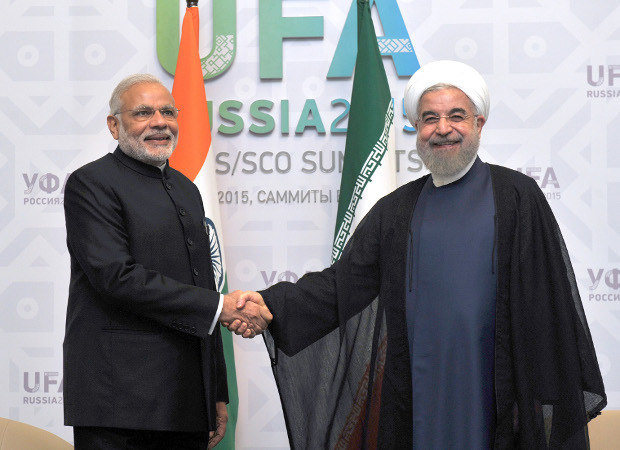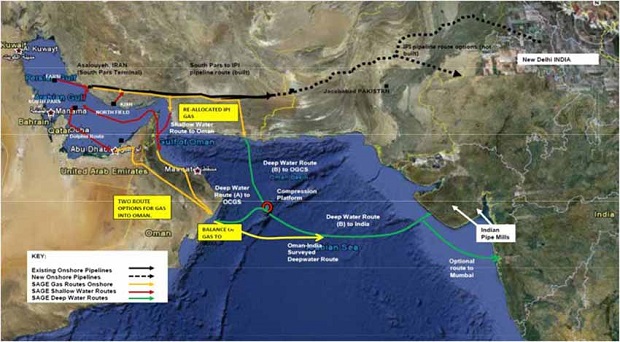How Iran’s Nuke Deal Could Boost India
Prime Minister Narendra Modi with Iranian President Hasan Rouhani in Ufa, Russia on July 9, 2015.
India hopes for a new business bonanza from Iran, after the international community agreed to release a nine-year-old sanctions and trade embargo.
Iran’s Foreign Minister Javad Zarif visits India on August 14, the first ministerial visit to India after Iran signed a historic and controversial nuclear deal with the West on July 14, 2015. India has welcomed the nuclear deal.
Zarif is expected to meet Prime Minister Narendra Modi, External Affairs Minister Sushma Swaraj and Transport Minister Nitin Gadkari.
Here are some benefits predicted for India:
- India’s exports to Iran are expected to jump over a third to $6 billion this financial year, according to this report (However, some traders fear competition from global suppliers).
- Iran’s gas reserves, one of the world’s largest, are important for India’s gas-starved power plants, which provide clean energy in a coal-dependent country.
- Iran will offer Indian companies a slew of infrastructure projects, including developing a vital port that will allow access to central Asia and Afghanistan, bypassing hostile Pakistan; and a transport corridor into Russia.
A chance to renew ancient ties
India and Iran shared a border until 1947, and there are ancient cultural and political ties between the two countries. Indeed, Persian was once the language of India’s ruling class.
India and Iran maintained cordial relations during the nine years of United Nations sanctions.
India is Iran’s largest oil importer after China, and the world’s fourth-largest oil consumer. Iran ranks fifth in terms of India’s oil imports from Middle-East.
Source: LokSabha/PIB; Figures in Million Metric Tonnes (MMT)
India’s crude oil imports from Iran almost halved from 21 million metric tonnes (MMT) in 2009-10 to 11 MMT in 2014-15. Washington recently acknowledged India’s economic sacrifices in supporting sanctions against Iran.
How India weaned itself off Iranian oil
In May 2012, Hillary Clinton, then US secretary of State, made a short visit to India, which was thought as her farewell trip to New Delhi. Clinton later disclosed in her book ‘Hard Choices’ that the visit was solely to convince India to reduce its reliance on Iranian oil, which India eventually did.
Oil imports from Iran declined 28% the following year.
India’s crude oil imports from Iran dropped to zero in March this year due to US pressure. However, it increased 65% in May 2015 over the previous year, ahead of the final talks by international negotiators over Iran’s nuclear deal in June, according to this Reuters report.
Complying with US sanctions also affected India’s bilateral trade with Iran.
India’s bilateral trade with Iran increased eight-fold between 2005-06 and 2011-12, from $2 billion to $16 billion, declining to $13 billion in 2014-15.
India’s imports declined 36%, from $14 billion in 2011-12 to $9 billion in 2014-15. India’s major commodity import from Iran was mineral fuel-oils (including bituminous substances and mineral waxes) worth $7 billion in 2014-15.
Exports to Iran stood at $4 billion in 2014-15 with cereals—the leading export commodity—worth $1 billion in 2014-15.
Iran’s major purchases in cereals have been basmati rice and sugar, and India has been using the rupee credit for its oil due to restrictions on dollar trades. India is Iran’s top rice supplier.
Iran Can Fulfil India’s Gas Requirements
Iran is an energy-rich country, with the world’s fourth-largest proven reserves of crude oil and one of the world’s largest natural-gas reserves.
A slew of unfolding gas projects is vital to India. Gas-based power accounts for just 10% of installed electricity generation capacity. More than 23,000 MW of natural-gas-fired power plants operate at a fraction (20%) of capacity due to lack of fuel, IndiaSpend has reported.
India’s Oil and Natural Gas Corporation Videsh (OVL) had discovered the Farzad-B gas field in the Persian Gulf in 2008, which had recoverable gas reserves of an estimated 12.8 trillion cubic feet.
International pressure forced India to quit, after it invested $90 million in exploration, according to this report.
Iran has now reopened the bid, and Indian companies are set to face competition from western firms, once sanctions are lifted.
An Iran-Pakistan-India (IPI) gas pipeline project has been under discussion since 2005, but there has been no progress.
Another ambitious project for India is the $4 billion Middle-East-to-India-Deepwater Pipeline (also called the South Asia Gas Enterprise project), expected to supply 31 million cubic meters of gas per day to India once implemented.
The 1,300-km-long pipeline will start from Chahbahar in Iran and Ras Al-Jifan in Oman. After traversing the deep bed of the Arabian Sea and bypassing Pakistan, it will reach Porbandar in Gujarat. The project could also bring Turkmenistan gas to India through a swap arrangement with Iran from a gas field in the Arabian Sea.
Map used with permission from SAGE
Iran offers India access to central Asia and Russia
Iranian President Hassan Rouhani has offered India an opportunity to invest in infrastructure and connectivity projects worth $8 billion. Rouhani met Modi in July on the sidelines of a BRICS summit in Russia, and the Iranian President suggested a larger role for India.
India signed an agreement with Iran in May 2015 to develop the Chahbahar port on Iran's south-eastern coast, which will give India sea-land access to Central Asia and Afghanistan, bypassing Pakistan.
India will invest $85 million to outfit two berths, one as a container terminal, the second as a multi-purpose cargo terminal.
India is also part of the International North-South Transport Corridor, a multimodal transportation system connecting India, Central Asia and Russia via Iran.
The project can reduce cargo-transport time to Russia, from the current 45-60 days to 25-30 days. A successful dry-run was conducted last year. ¦
(Mallapur is a policy analyst with IndiaSpend.)
Image credit: Press Information Bureau
________________________________________________________________
“Liked this story? Indiaspend.com is a non-profit, and we depend on readers like you to drive our public-interest journalism efforts. Donate Rs 500; Rs 1,000, Rs 2,000.”




